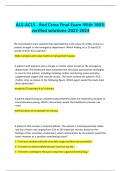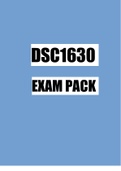ALS-ACLS - Red Cross Final Exam-With 100%
verified solutions-2023-2024
The resuscitation team suspects that hyperkalemia is the cause of cardiac arrest in a
|;, |;, |;, |;, |;, |;, |;, |;, |;, |;, |;, |;, |;,
patient brought to the emergency department. Which finding on a 12-lead ECG
|;, |;, |;, |;, |;, |;, |;, |;, |;, |;, |;, |;,
would confirm this suspicion?
|;, |;, |;, |;,
Wide-complex ventricular rhythm or tall, pointed T waves |;, |;, |;, |;, |;, |;, |;,
A patient with dyspnea and a change in mental status arrives at the emergency
|;, |;, |;, |;, |;, |;, |;, |;, |;, |;, |;, |;, |;,
department. The healthcare team completes the necessary assessments and begins
|;, |;, |;, |;, |;, |;, |;, |;, |;, |;,
to care for the patient, including initiating cardiac monitoring, pulse oximetry,
|;, |;, |;, |;, |;, |;, |;, |;, |;, |;, |;,
supplemental oxygen and vascular access. The team reviews the patient's ECG
|;, |;, |;, |;, |;, |;, |;, |;, |;, |;, |;,
rhythm strip, as shown in the following figure. Which agent would the team most
|;, |;, |;, |;, |;, |;, |;, |;, |;, |;, |;, |;, |;, |;,
likely administer?
|;, |;,
Atropine 0.5 mg every 4 to 5 minutes |;, |;, |;, |;, |;, |;, |;,
A patient experiencing an unstable bradyarrhythmia does not respond to atropine or
|;, |;, |;, |;, |;, |;, |;, |;, |;, |;, |;,
transcutaneous pacing. Which intervention would the healthcare provider use
|;, |;, |;, |;, |;, |;, |;, |;, |;,
next?
|;,
Administration of an epinephrine infusion |;, |;, |;, |;,
A patient's ECG reveals a tachyarrhythmia. The patient is hemodynamically stable
|;, |;, |;, |;, |;, |;, |;, |;, |;, |;,
and has a heart rate ranging from 120 to 135 beats per minute. Based on the
|;, |;, |;, |;, |;, |;, |;, |;, |;, |;, |;, |;, |;, |;, |;, |;,
findings of the secondary assessment, which statement(s) by the patient would the
|;, |;, |;, |;, |;, |;, |;, |;, |;, |;, |;, |;,
team interpret as a possible contributing cause?
|;, |;, |;, |;, |;, |;, |;,
1. "I've had a terrible cold with a horrible cough and fever the past week."
|;, |;, |;, |;, |;, |;, |;, |;, |;, |;, |;, |;, |;,
2. "I've been so anxious lately because I just lost my job."
|;, |;, |;, |;, |;, |;, |;, |;, |;, |;,
3. "I've been vomiting for the past 2 days from a gastrointestinal bug."
|;, |;, |;, |;, |;, |;, |;, |;, |;, |;, |;,
, A patient's ECG reveals a narrow QRS complex with a regular rhythm, indicating a
|;, |;, |;, |;, |;, |;, |;, |;, |;, |;, |;, |;, |;,
narrow-complex supraventricular tachyarrhythmia. The patient is hemodynamically
|;, |;, |;, |;, |;, |;, |;,
stable. Which intervention would be initiated first?
|;, |;, |;, |;, |;, |;, |;,
Vagal maneuvers |;,
A patient in the telemetry unit is stable. Cardiac monitoring indicates the patient has
|;, |;, |;, |;, |;, |;, |;, |;, |;, |;, |;, |;, |;,
ventricular tachycardia with a pulse. Further assessment reveals that the corrected
|;, |;, |;, |;, |;, |;, |;, |;, |;, |;, |;,
QT interval is greater than 0.46 seconds. Which treatment would be appropriate at
|;, |;, |;, |;, |;, |;, |;, |;, |;, |;, |;, |;, |;,
this time?
|;, |;,
Synchronized cardioversion |;,
An ECG strip of a patient in the emergency department reveals the following
|;, |;, |;, |;, |;, |;, |;, |;, |;, |;, |;, |;,
rhythm. Which feature would the healthcare provider interpret as indicating atrial
|;, |;, |;, |;, |;, |;, |;, |;, |;, |;, |;,
fibrillation?
| ; ,
Absence of discrete P waves and presence of irregularly irregular QRS
|;, |;, |;, |;, |;, |;, |;, |;, |;, |;,
|;, complexes A patient is brought into the emergency department. The patient |;, |;, |;, |;, |;, |;, |;, |;, |;, |;,
does not have a
|;, |;, |;, |;,
pulse. The cardiac monitor shows the following rhythm. The team interprets this as
|;, |;, |;, |;, |;, |;, |;, |;, |;, |;, |;, |;,
which condition?
|;, |;,
Ventricular tachycardia |;,
A patient with acute renal failure experiences cardiac arrest. Just before the cardiac
|;, |;, |;, |;, |;, |;, |;, |;, |;, |;, |;, |;,
arrest, the patient's ECG showed peaked T waves. What might be causing the
|;, |;, |;, |;, |;, |;, |;, |;, |;, |;, |;, |;, |;,
patient's cardiac arrest?
|;, |;, |;,
Hyperkalemia
A member of the resuscitation team is preparing to defibrillate a patient in cardiac
|;, |;, |;, |;, |;, |;, |;, |;, |;, |;, |;, |;, |;,
arrest using a biphasic defibrillator. The team member would set the energy dose
|;, |;, |;, |;, |;, |;, |;, |;, |;, |;, |;, |;, |;,
according to the manufacturer's recommendations, which is usually:
|;, |;, |;, |;, |;, |;, |;, |;,
120 to 200 joules |;, |;, |;,





